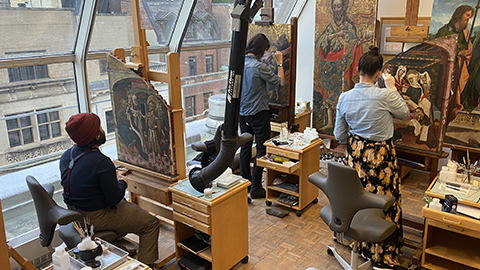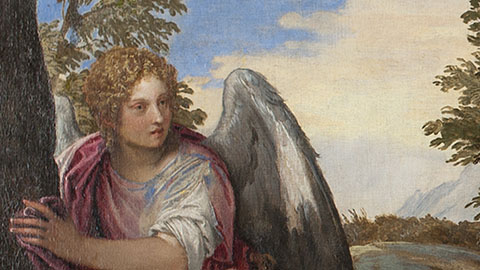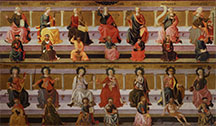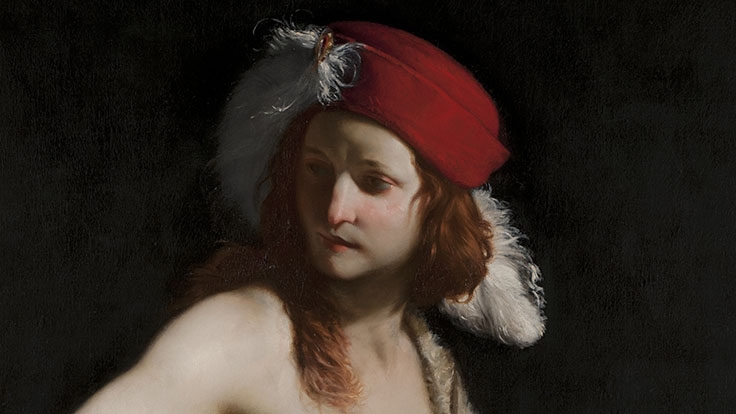Glossary (M-Z)
Conservation uses specialized terminology which may be unfamiliar to some. We have created this illustrated glossary defining and discussing some frequently referenced terms and concepts.
M
Medium
See (Binder)
Metamerism
A phenomenon relating to pigments having different signature absorption spectra, whereby two paints can appear the same color under one type of illumination but no longer match in hue under another set of conditions. This color shifting must be closely monitored when performing retouching to ensure the color match is accurate across a range of light temperatures. Paints containing predominantly blue or yellow pigments are particularly susceptible to metamerism.
Mordant
An adhesive used in the process of gilding to adhere metal leaf, usually to create gilded decorations on painted passages of drapery and secondary elements such as helmets, bridles, sword hilts and architecture. The mordant can be based on mixtures of oils and resins or a sticky, aqueous materials such as fish glue, gum, or even garlic juice have also been used. Oil/resin mordants often contain pigments. In Northern Europe, mordant gilding is sometimes used instead of water gilding for backgrounds.
Photomicrograph of mordant gilding.
Lorenzo Monaco, The Crucifixion, c. 1400, Mead Art Museum, K93.
Image credit: Rita BergO
Oil Painting
Pigments bound with a drying oil, such as linseed oil or walnut, although poppy seed oil was also used. It does not dry through evaporation of volatile components from the mixture, but by a complex process of polymerization that takes place over many decades, eventually developing an enamel-like depth and translucence. Drying oils were known for centuries but the invention of oil painting, following Vasari’s assertion, was long attributed to Jan van Eyck. His skill in exploiting its possibilities so far exceeded that of his contemporaries that throughout the 19th and into the early 20th century many scholars believed that he had a secret formula. Eventually analyses established that his medium contained only drying oil. The handling properties of oil paint - the smooth blending of transitions, the creation of form and spatial recession with the use of translucent glazes and scumbles - allowed artist to imitate reality with wondrous verisimilitude. Its properties could be varied by adding various ingredients to speed up or retard the drying time, thin the paint, or create texture. Oil paint can be used to create innumerable effects, from the glassy surfaces of French Academic paintings to the high impasto squeezed directly from the tube favored by Van Gogh.
Dry pigments were ground by hand into the oil medium and the paint placed into sealed pig bladders. To extract the paint, the bladder was pierced with sort of tack made of bone or wood and then resealed. A bladder of paint could last for many months. In 1841 an American painter named John Rand invented the collapsible paint tube. As Renoir said, without paint in tubes there would not have been Impressionism since the portability of the paint tube allowed artists to emerge from their studios.
Drying oil is an exceptionally durable material once fully dry. But many oil paintings develop film defects such as contractions cracks and wrinkling for numerous reasons when artists add experimental materials or fail to take certain precautions. (See Craquelure)
Detail of oil paint passages in Ignacio Yriarte, Landscape with Tobias, 17th century, Allentown Art Museum, K1536.
Image credit: Kristin HolderOverpaint
Overpaint is retouching applied during a past restoration that is not confined to areas of loss but goes over the artist’s original paint. Often it is quite old, difficult to remove, and may pre-date the most recent restoration. It may have been applied to suit the restorer’s idea of how a passage should be painted, to camouflage elements of a composition considered to be undesirable, or to mask severe damage. In many instances, well-preserved original can be recovered by removing overpaint.
During the removal of wholesale overpainting, revealing original, well-preserved lapis blue passages in the drapery.
Giovanni Agostino da Lodi, Madonna and Child, c. 1520, Vanderbilt University Fine Arts Gallery, K1217.
Image credit: Annika FinneP
Panel
Panels made from various types of wood were the principal supports for paintings until the early sixteenth century when canvas began to supersede them. In Northern Europe, panels were usually made from oak, which have proven to be among the sturdiest. A hard wood, resistant to woodworm, oak supports are thinner and usually have a beveled edge. The quality of their manufacture was controlled by strict guild regulations in Germany and the Netherlands. In Antwerp, panels that had passed inspection were branded with a special mark. Oak is also the only wood that can be dated by means of dendrochronology to the exact year the tree was cut down providing at least a terminus post quem.
In Southern Europe many different species were used. Poplar was widely employed, especially in Central Italy, but other species such as walnut, clear pine, cypress, willow, linden, maple, and fruit woods have also been identified. After the tree had been felled, they were left to lie on the forest floor to season, often for a decade a more. Seasoning is not the only factor that affects the stability of a panel. Much depends on the way the trunk was originally sawn. And some woods are more prone to insect infestation than others. Planks varied in size. Most were from 20-40 cm. (7 to 15 inches) wide but boards as wide as 60-70 cm. (23-27 inches) also occur. The thickness depended on the width: the range tends to be from 30 to 45 mm. (l.18-1.77 inches). To make larger supports, a number of boards were joined together with casein adhesive and usually some sort of support, such as battens, were added to the reverse.
Detail of the verso of a painting on oak panel.
Goswyn van der Weyden, Madonna and Child with Saint Anne, late 15th/early 16th centuries, Vanderbilt University Fine Arts Gallery, K2166.
Image credit: Emma KimmelPastiglia
Raised decorations on top of the gesso ground created with additional gesso. Pastiglia ornament can be applied and shaped by hand, or more elaborate decorations can be formed in a mold and adhered to the gesso ground. Pastiglia is usually water gilded.
Detail of pastiglia columns in the decorative arch.
Francescuccio Ghissi, The Resurrection of Drusiana, c. 1370, Portland Art Museum, K205A.
Image credit: Sayaka FujiokaPentimento
The word pentimento is derived from the Italian pentirsi, which means to repent or change one’s mind. A pentimento is a change made by an artist during the process of painting. Due to the increased translucency acquired by oil paint films as they age, pentimenti can sometimes be seen with the naked eye. Examination with imaging techniques that penetrate the various layers of paint, especially x-radiography and infrared reflectography, often reveal unsuspected pentimenti and can clarify the changes observed in visible light.
Detail of an infrared reflectogram (left), showing pentimenti in the poses of both figures.
Master of the Glasgow Adoration, A Baptismal Ceremony, c. 16th century, Vanderbilt University Fine Arts Gallery, K78.
Image credit: Shan KuangPigment
A coloring agent that when mixed with a binding medium forms paint. Pigments are derived from a variety of sources. Many come from naturally occurring materials such as colored earths and clays; minerals, such as azurite and realgar; plant matter such as charcoal from burnt vines, and dyes from certain berries or roots. Important translucent red lakes were made from dyes extracted from dried insects and cast onto a substrate, usually alum. Other pigments were synthesized. Lead white, essential to the palette because of its opacity and other properties, was made by exposing sheets of lead to the fumes of acetic acid; copper exposed to acetic acid fumes produced verdigris; mixing molten sulfur with mercury, grinding the mixture, and heating it to sublimation produced vermilion, the indispensable bright, opaque red.
The rarest and most costly pigment was natural ultramarine, made from the semi-precious stone, lapis lazuli. The mineral was ground in a wax-based paste and the colorant extracted with lye. The amalgam yielded various grades, the first wash being the most intensely colored. Subsequent rinsings became progressively grayer down to the lowest grade known as “ashes of ultramarine.” Not every painter had access to this fine blue. It was not only expensive but sometimes difficult to procure. A few monasteries specialized in its manufacture. Fra Angelico, as a Dominican monk living in San Marco, notably used the finest quality in great abundance. Perugino also appears to have had easy access to ultramarine blue. Most artists had to rely on the cheaper. Modern day synthetic ultramarine, invented in France in 1826, has come to replace the expensive natural one.
Cross section sample taken from blue drapery, with lapis lazuli pigment particles visible in the top paint layers.
Giovanni Agostino da Lodi, Adoration of the Shepherds, c. 1505, Allentown Art Museum, K1291.
Image credit: Shan KuangPouncing and Spolvero
Spolvero is derived from the Italian polvere, which means ‘dust.’ The term is used to describe part of a method for transferring a design, usually to a prepared panel, but also to canvas or intonaco. A one-to-one drawing for a composition, or for certain passages, was made on a cartoon. The outlines and major features were pricked, leaving a series of tiny holes. The cartoon was placed over the support, probably either pinned or fixed at the corners with temporary adhesive, and a small sack containing charcoal powder is ‘pounced’ through the holes leaving a dotted outline on the preparation. The dots were connected with a more permanent medium, either liquid or dry, and the charcoal residue blown away. Just enough clings to the gesso that these small dots can often be seen in infrared images along with the reinforced, drawn lines.
Infrared reflectogram detail showing pounced dots created during the transfer of the design, and then connected with drawn lines.
Adriaen Isenbrant, The Madonna and Child with a Member of the Hillensberger Family, 1513, Lowe Art Museum, K6.
Image credit: Shan KuangPunching and Tooling
Punchwork or tooling are general terms associated with the elaboration of water gilded backgrounds by applying decorative patterns using a number of techniques. Incised lines were the earliest form of tooling. Later decorations were added using punches, metal stamps with some sort of shape carved on the tip. When lightly struck with a special hammer made of strips of hide, the design was impressed into the gold background. There were a variety of motifs, from a simple indentation, circles, and half circles of various sizes, which could be combined to form more complex designs, to complete motifs such as a rosette, star, or trefoil arch. Punched designs were often accompanied by incising. The right timing was essential: tooling could only be done when there was just enough humidity in the bole/gold to take a good impression. If the substrate was too damp, the punch sank in, while if too dry, only a shallow impression was made. Tooling and punching created sparkle in the already shiny burnished gold and liveliness as the shifting light of the candles played over the surface.
Tooled backgrounds were often further embellished with glazes or layers of opaque paint that were subsequently partly scraped off to form a design. This technique is called sgraffito and was brought to a high state of refinement by painters of the fourteenth and fifteenth century Sienese school such as Simone Martini, Bartolomeo Bulgarini, and Giovanni di Paolo.
Photomicrograph of leaf, flower, and point punches.
Sano di Pietro, The Virgin in Adoration of the Christ Child with Saints Bernard and Bernardino and Angels, 15th century, Mead Art Museum, K311.
Image credit: Annika Finne and Dianne ModestiniR
Retouching (Compensation, Inpainting)
Retouching describes the paint applied by a restorer to replace areas of loss or damage, which disrupt the visual harmony of an image. Contemporary conservation guidelines specify that the materials used be reversible and that retouching be confined to actual areas of loss, however, for passages of paint that have been abraded by past cleaning and lost their final modelling layer, it is permissible to go over the original paint with thin glazes. Retouching is executed with a medium that will not discolor over time and remain easily soluble. Many different mediums are used: dry pigments bound with stable synthetic resins or with egg tempera; commercial formulations such as watercolors, gouache, or paint made specifically for retouching such as Gamblin Colors or Maimeri Restoration Colors. Often different mediums are layered over one another to imitate the enamel of the original paint more closely. Only stable pigments are used: some historic colors, such as vermilion, for example, alter and are replaced by cadmium reds. Other colors on the restorer’s palette are the same as those originally used by the artist. Under ultraviolet light retouches appear dark because they do not fluoresce but rather reflect the purplish light of the lamp.
Painting conservator, Kristin Holder, retouching abrasion and losses in Landscape with Tobias by Ignacio Yriarte (17th century, Allentown Art Museum, K1536).
Image credit: Nita RobertsS
Scumble
A thin layer of semi-opaque paint of a warmer more intense hue, and lighter color applied over a darker underpaint. The dark underlayer makes the thin scumble appear cooler and bluer. 17th century painters working on dark grounds exploited this method for quickly establishing form. Unfortunately, due to the increase in translucency of oil paint as it polymerizes, these thin final scumbles often effectively disappear leaving only the color of the underpaint. Because they are thin and medium-rich, they are also vulnerable to strong cleaning. In retouching, optical scumbles can be used to lift stains using opaque pigment mixtures.
Cleaned state detail showing an abraded scumble layer in the sky, revealing the darker blue underlayer.
Master of the Glasgow Adoration, A Baptismal Ceremony, c. 16th century, Vanderbilt University Fine Arts Gallery, K78.
Image credit: Shan KuangSgraffito
The technique of scratching off an upper layer of tempera paint to reveal the underlayer (usually gold leaf). Sgraffito is most often used in drapery patterns of gold ground paintings to create rich decorative effects. The elaboration of sgraffito as a decorative technique is associated particularly with Sienese painting and with artists such as Gentile da Fabriano and his followers.
Detail of sgraffito used to indicate feathers in the cherubims.
Sano di Pietro, The Virgin in Adoration of the Christ Child with Saints Bernard and Bernardino and Angels, 15th century, Mead Art Museum, K311.
Image credit: Dianne Dwyer ModestiniSpectrum
The parts of the electromagnetic spectrum used for viewing and studying art, range from the shortest wavelength, x-rays under 1nm; ultraviolet rays from 1-400nm; visible light from 400-700nm; and infrared rays from 700 to 2500nm.
Spolvero
See (Pouncing)
Stretcher
A wooden frame on which canvases are mounted so that they can be primed and painted. The stretcher with expandable corners was invented in the 18th century. The earliest examples had a single key at each of the four corners. Later the concept was perfected by the development of stretchers with adjustable mortise and tenon joins at the corners that permitted the insertion of two keys, allowing differential expansion of the canvas. The number of cross bars depends on the size of the stretcher. In a well-made stretcher the cross bars also have slots for keys. Canvases are fixed to the sides of the stretcher with nails, tacks or in modern times, staples. This is known as “the tacking edge.” Before the invention of the stretcher, canvases were mounted on strainers, whose corners were fixed. The canvas could be nailed either to the sides of the strainer or to the front, which was then covered by a decorative molding.
Reverse of a canvas painting, showing a typical modern stretcher.
Sebastiano Ricci, Jephthah and His Daughter, c. 1710, Memphis Brooks Museum of Art, K1704.
Image credit: Dianne Dwyer ModestiniStripped
This term has several meanings. After all the discolored varnish, retouches, and repaints have been removed during cleaning, a painting is sometimes said to be in its “stripped” state. It also refers to paintings that have been so strongly cleaned that they have lost their final modelling.
Stripped state (or cleaned state) photograph during treatment, before retouching.
Cesare da Sesto, Madonna and Child with Saint John the Baptist and Saint George, c. 1513-15, Fine Arts Museums of San Francisco, K1625.
Image credit: Dianne Dwyer ModestiniStucco
Stucco has been used since ancient times. It is a material made variously of gypsum or lime plasters, sand, marble dust, chalk, water, and other materials. It has a relatively short working time and sets by oxidation of the lime or gypsum plaster component. It has been used to create bas reliefs, either by pressing the stucco into a mold or by carving it by hand. In the 18th century, rooms and church interiors were decorated with elaborate rococo ornamentation created by specialized artists using molds for some of the simpler elements such as moldings and casts for larger features, such as putti, angels, and other major three-dimensional features.
Supports
Many materials have been used as supports for paintings. The most common are wood panels; canvases made of various textiles and weaves; paper; and copper. Slate, obsidian, colored marbles, semi-precious stones, mirrors, and parchment are also occasionally used. Beginning in the early twentieth century synthetic supports made of pressed wood and paper were also popular.
T
Tempera
Tempera can refer either to a painting in egg tempera medium, or as shorthand for distemper, a medium made from animal glue in water. Most paintings in distemper are painted directly on a finely woven linen, also known as tüchlein, without any intermediate priming or preparation.
Detail of hatched brushwork characteristic of egg tempera painting.
Sano di Pietro, Madonna and Child, c. 1450, Kress Foundation, K1036.
Image credit: Kristin HolderTransfer
Transfer refers to the removal of paint and preparatory layers from their original support and adhering them to a new one. The technique originated in Italy at least by the early 1700's but became popular and found widespread use in France in the later 18th century. Jean-Louis Hacquin was its most famous promoter and practitioner although there were other large firms. From Paris, the practice migrated to Saint Petersburg in the early 19th century where a series of restorers transferred almost every painting on panel to canvas. Deterioration of the original wood was the principal reason for panel to canvas transfers although the condition of the gesso preparation also was an issue: when kept in damp places, the glue that bound the gesso layers could deteriorate causing the paint to separate. The transfer process involved adhering a series of protective layers to the front of the painting; placing it face down to chisel away the panel from the reverse; sometimes removal of the original preparation; the application of a new ground and canvas. The whole assemblage was often dried in a press, or it could be ironed, before mounting it on a stretcher. The facing materials were then removed. In the 20th century paintings were usually transferred to solid supports of pressed wood or Masonite, rather than canvas. An interesting feature of transferring a painting from panel to canvas is that the reverse of the paint layer is exposed. Before imaging was available, this was a unique opportunity to study the process of painting. The procedure requires enormous care and skill. A great deal of damage was done in the past by incompetent restorers. One of the most famous casualties is Leonardo da Vinci's Virgin of the Rocks in the Louvre, which suffered grievous paint loss during a botched transfer. There are also canvas to canvas transfers, but they are not as common. In modern conservation, the wood panel itself is treated and wood science has been brought to bear on the study of individual problems.
Black and white photograph of the reverse of the paint layer during transfer (c. 1950), clearly revealing an underdrawing of lines incised into the original gesso ground laying out the initial contours of the figure.
Master of the Greenville Tondo, Saint Sebastian, c. 1500-10, Princeton University Art Museum, K1557.
Image courtesy of NGA Kress Collection of Historical ImagesU
Underdrawing
Drawing is the first stage in the creation of a painting and is nearly ubiquitous. It can be done in a wet or dry medium the color can be black, red, brown, or white. Some underdrawings are highly elaborate while others are very summary. Sometimes it makes use of elements such as hatching in the shadows that were meant to be seen as part of the final image. It can be freehand or traced from a cartoon or an intermediate drawing. Advances in imaging in the past few years have revealed the presence of underdrawing in works by artists who were traditionally thought to have foregone this stage of creation and begun with an underpainted sketch, such as Caravaggio.
Freehand underdrawing as seen in the infrared reflectogram.
Domenico Beccafumi, Adoration of the Shepherds, c.1545/50, Allentown Art Museum, K559.
Image credit: Shauna YoungUnlined
Canvas supports deteriorate over time and become brittle, making them vulnerable to a variety of mishaps, such as tears, broken tacking edges, and buckling. To correct these damages and deformations, paintings have frequently been backed with a supplementary canvas, usually linen, glued to the back of the original with a variety of adhesives: glue paste; wax resin; synthetic polymers of various sorts. It is extremely rare for a painting that predates the 19th century to be unlined. All historic relining techniques require the use of heat, pressure and, in the case of glue linings, moisture. While some linings were carefully done and have not altered the original surface texture, most have caused some flattening of the paint. Occasionally paint surfaces were burned by excessively hot irons. Relining is still occasionally necessary but has fallen out of use in modern conservation practice, replaced by less invasive treatments and more care is taken in the application of heat and pressure.
Ultraviolet Radiation
Ultraviolet radiation, a wavelength on the electromagnetic spectrum shorter and more energetic than the visible light range, excites a characteristic fluorescence in many materials. Aged resins exhibit a greenish fluorescence, shellac looks orange, glue somewhat blue, and the fluorescence of certain pigments is so strongly colored that they can be identified without further scientific analysis. Red madder, for example, turns brilliant pink in UV light.
In conservation it is used to check the progress of varnish removal during cleaning, and to identify retouches.
Photograph in ultraviolet illumination during varnish removal, showing fluorescing resin (left).
L'Ortolano, The Dead Christ Sustained by Nicodemus, 1520-22, Samek Art Museum, K1752.
Image credit: Bryanna KnottsV
Varnish
Varnish is applied to saturate the colors of a painting, particularly the dark passages of oil paintings, which tend to become matte and blanched once they are fully dry. Painters’ practice regarding initial varnishing varied widely with school and period. Early Italian egg tempera paintings were sometimes given a coat of glair, or beaten egg white, to seal the surface, avoiding the thick coatings of resin in oil that would overwhelm the fresh hues of the technique. In general, it was thought advisable to refrain from varnishing for a certain period of time until the fresh paint film had a chance to settle. Early oil varnishes are not easily soluble, and the methods used to remove them, including caustic substances, often damaged the original paint. By the end of the fifteenth century thinner coatings made from resins such as mastic or dammar dissolved in turpentine were available and continued to be used until the present day. All natural resin varnishes deteriorate and discolor, becoming yellow and even brown. By the late nineteenth century some painters, notably the Impressionists, rejected the practice of wholesale varnishing carried out before the opening of Salon exhibitions, known as the vernissage, and specified that their canvases should be unvarnished, glazed, or given a thin coating of wax. Since that time, varnishing has become a vexed topic. Once admired for the golden glow it imparted, its removal sparked numerous cleaning controversies, notably at the National Gallery in London. In the twentieth century scientists and conservators began to experiment with the use of synthetic polymers as a substitute for natural resins, believing that they would be more stable. A number of acrylic resins were used and even provided as commercial formulations. Many were rather large molecules with a high viscosity and failed to saturate the surface, especially dark passages. Over time they tended to become gray and opaque, either due to absorption of dirt or because they formed a film that separated from the paint surface. It was also supposed that they would be more easily soluble than natural resins, but this proved to be a disappointment as some of the resins cross-linked and all of them required the use of toxic benzenes to remove. Some low molecular weight synthetic resins are presently used in varnish formulations and scientists have identified some additives to stabilize natural resins, particularly mastic, still preferred by many conservators because of its superior handling properties and predictability.
During the removal of darkened varnish (interlayers of oxidized shellac and dammar).
Workshop of Quentin Massys, Saint Christopher, c. 1490, Allentown Art Museum, K1903.
Image credit: Shan KuangVerdaccio
A greenish grey underlayer used to underpaint flesh tones in early Italian paintings. Cennino Cennini’s formula is a mixture of black, white, and yellow ochre pigments but green underpaint has many variations and can range from bright green to a warm grey. He also describes were to apply it advising that for some figures, such as an old man or a corpse, the layer is darker and can be more dominant. Green underpaint for flesh tones persisted through the early 15th century, although usually in conjunction with egg tempera rather than oil paint. The shades were usually a pale mint color for the highlights and a slightly darker warmer green for the shadows. Botticelli, Ghirlandaio, and even Michelangelo continued to adopt this system.
Intensely green verdaccio underlayer visible in the flesh tone.
Master of the Clarisse, possibly Rinaldo da Siena, Madonna and Child with Four Saints, c. 1285, Memphis Brooks Museum of Art, K1930.
Image credit: Derek LintalaW
Wet in Wet
See (Alla Prima)
X
X-Radiography
X-rays are short, high energy wavelengths that can penetrate through all the layers of a painting. The image produced, a radiograph, essentially maps the distribution of pigments containing lead, such as lead white, and to a lesser degree, other heavy elements such as mercury-based vermilion, that x-rays cannot pass through. Radiographs are useful for identifying pentimenti, studying the canvas weave and distortions along the tacking margins that indicate the original size, examining brushwork, and recording paint losses.
A newer imaging technique called MA-XRF mapping uses X-rays to ionize the atoms in a paint film, which emit radiation characteristic of certain elements. The data from metallic elements associated with certain pigments is used to create a map of their distribution. The ability to isolate mercury, for example, the principal component of vermilion, copper, contained in several blue pigments, particularly azurite, or iron, a constituent of earth pigments, renders images that provide more selective information about the artist’s process. Pentimenti are more clearly revealed as well lost detail in passages painted with a pigment that has altered and become illegible.
Detail of x-radiograph showing the canvas weave, bold brushwork, and pentimento of the outstretched hand.
Sebastiano Ricci, Jephthah and His Daughter, c. 1710, Memphis Brooks Museum of Art, K1704.
Image credit: Shan Kuang







